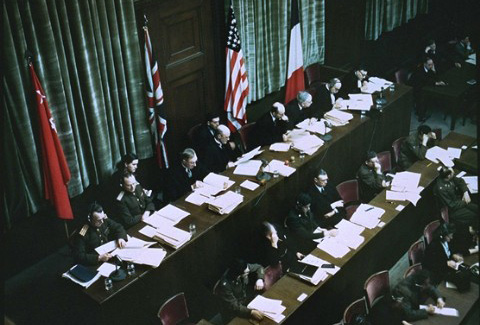
Seventy years ago, on October 18, 1945, the chief prosecutors of the International Military Tribunal (IMT) ordered read the indictments against 24 leading Nazi officials. The charges brought against these officials were:
1. Conspiracy to commit crimes against peace, war crimes, and crimes against humanity
2. Crimes against peace
3. War crimes
4. Crimes against humanity
After this announcement, the trials formally opened in Nuremberg, Germany, on November 20, half a year after Germany surrendered. Each of the four Allied nations – the United States, Great Britain, the Soviet Union, and France – supplied a judge and a prosecution team. Lord Justice Geoffrey Lawrence of Great Britain served as the court’s presiding judge. The trial’s rules were the result of delicate reconciliations of the Continental and Anglo-American judicial systems.
Simultaneous translations of all proceedings were provided in English, French, German, and Russian.
Beginning in 1942, the Allied powers announced their intent to punish Nazi war criminals. The temptation was great to proceed directly to summary executions instead of trials. But in the words of Cordell Hull, Pres. Franklin D. Roosevelt’s long-serving Secretary of State, “a condemnation after such a proceeding will meet the judgment of history, so that the Germans will not be able to claim that an admission of war guilt was extracted from them under duress.”
The first group ofdefendants represented a cross-section of Nazi diplomatic, economic, political, and military leadership. The IMT defined crimes against humanity as “murder, extermination, enslavement, deportation…or persecutions on political, racial, or religious grounds.”
The charge of conspiracy was added to cover crimes committed under domestic Nazi law before the start of World War II, and so that subsequent tribunals would have jurisdiction to prosecute any individual belonging to a proven criminal organization, such as the Reich Cabinet, the Leadership Corps of the Nazi Party, the Elite Guard (SS), the Security Service (SD), the Secret State Police (Gestapo), the Stormtroopers (SA), and the General Staff and High Command of the German Armed Forces.
Testimony presented at Nuremberg revealed much of what we know about the Holocaust including the details of the Auschwitz death machinery, the destruction of the Warsaw Ghetto, and the estimate of six million Jewish victims. The term “genocide” entered the international language.
The judges delivered their verdict on October 1, 1946. Three of four judges were needed for conviction.
Twelve defendants were sentenced to death, among them Joachim von Ribbentrop, Hans Frank, Alfred Rosenberg, and Julius Streicher. They were hanged, cremated in Dachau, and their ashes dropped in the Isar River. Hermann Goering escaped the noose by committing suicide the night before. The IMT sentenced three defendants to life imprisonment and four to prison terms ranging from 10 to 20 years. It acquitted three of the defendants.
The IMT trial at Nuremberg was just one of the earliest and most famous of several war crimes trials. The overwhelming majority involved lower-level officials and officers, such as concentration camp guards and commandants, police officers, members of the Einsatzgruppen (mobile killing units), and doctors who participated in medical experiments. These war criminals were tried by military courts in the British, American, French, and Soviet zones of occupied Germany and Austria, and also in Italy in the immediate postwar years.
On October 17, 1946, the day after the IMT defendants were executed, Pres. Harry Truman appointed Telford Taylor to be the new American chief war crimes prosecutor. He went on to prosecute 183 high-ranking German officials, as well as German industrialists, in 12 separate trials known asSubsequent Nuremberg Proceedings.
Other war criminals were tried by courts in those countries where they had committed their crimes. In 1947, a court in Poland sentenced Auschwitz camp commandant Rudolf Hoess to death. In the courts of West Germany, many former Nazis did not receive severe sentences: Their claim of following orders from superiors was often ruled a mitigating circumstance. A number of these criminals returned to normal lives in German society, especially in the business world.
Dedicated Nazi hunters such as Simon Wiesenthal and Beate Klarsfeld found many hidden criminals who had escaped from Germany after the war. The trial of Adolf Eichmann, held in Jerusalem in 1961, captured worldwide attention.
Many war criminals, however, were never brought to trial or punished.
Principal source: United States Holocaust Memorial Museum.
Photo: The Soviet, British, American, and French flags hang behind the International Military Tribunal judges’ bench. Credit: National Archives and Records Administration, College Park, Md.












Comments